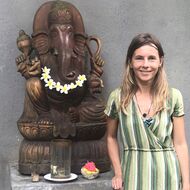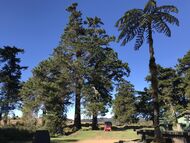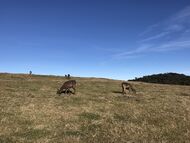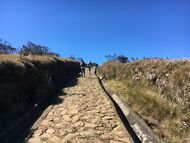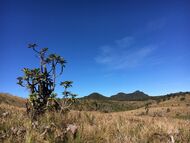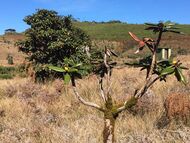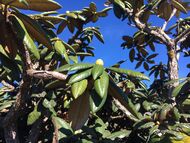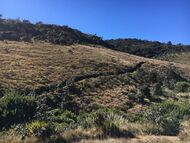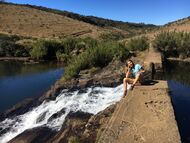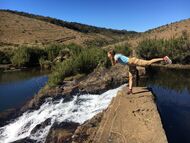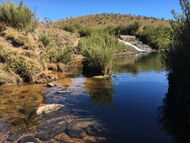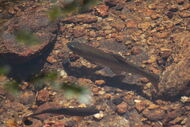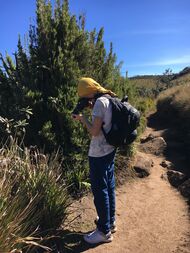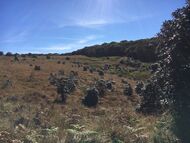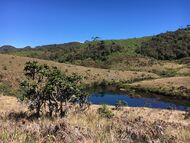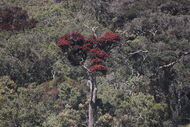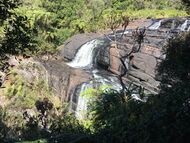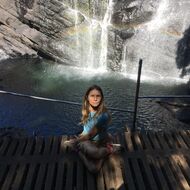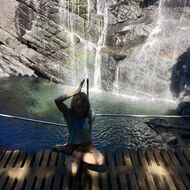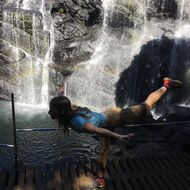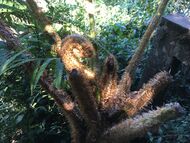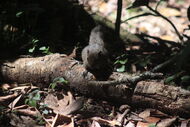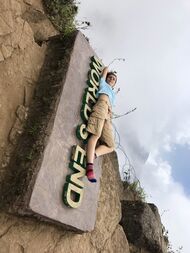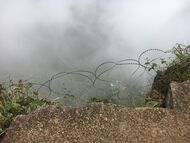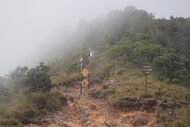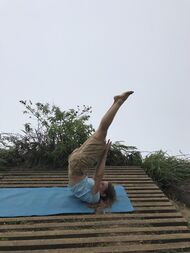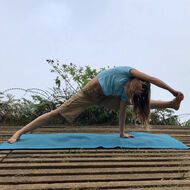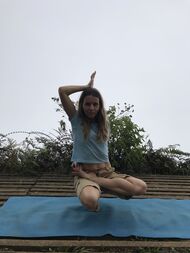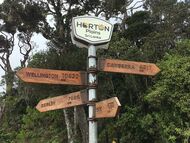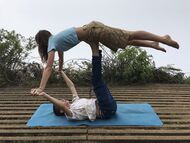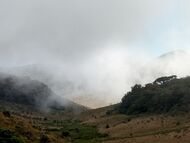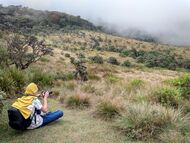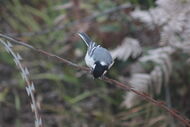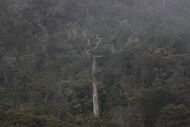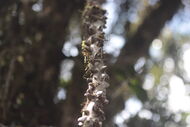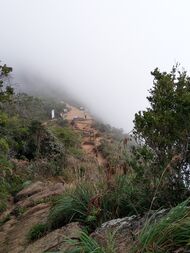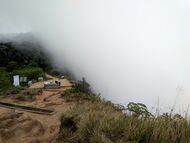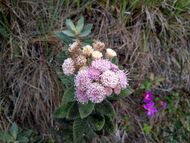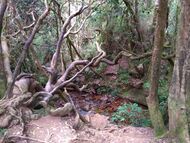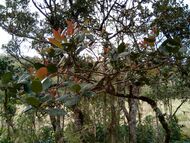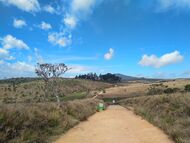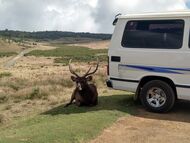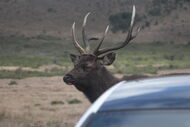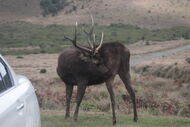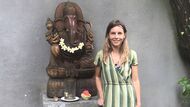Yoga at World's End
A walk along Horton Plains
The World’s End on the Horton Plateau is one of the most amazing places! The first picture, where a palm tree is adjacent to a pine tree demonstrates that very contrast and diversity of Horton Plains – the neighborhood of meadows and pastures (patanas) and a humid, evergreen, mountainous forest. The boundaries between the zones are surprisingly sharp and it seems that reality divides as you progress, and one zone replaces another, as if by magic.
It was terribly cold at dawn when we arrived: a gusty icy wind was blowing, the concrete benches were cold, and the bright morning sun did not warm. Large deer grazed peacefully in the meadows.
A rocky road led down from the hill, reminiscent of the yellow brick road from The Wizard of Oz, surrounded by thickets of dwarf bamboos and rhododendrons. On both sides stretched yellow steppe. Crystal clear bright blue water sparkled in ponds and a stream, and many dragonflies and butterflies scurried around. There was a feeling that you were not in Sri, but in Mexico or Kansas with its steppes, or maybe even on the “bald” Crete scorched by the summer sun, except perhaps without the sound of cicadas. However, sweet-voiced birds sang and nimble lizards scurried about. The yellow steppes, spreading on both sides of the road, turned higher into multi-colored hills, also strewn with rhododendrons. Rhododendron blooms from April to June and therefore it yet had only yellow bumps. The trunks of rhododendrons are similar to the trunks of olives: silvery, knotty, rough, twisted trees, from afar, in the form of trunks reminiscent of Mexican or Spanish cactuses. Violet, yellow, indigo-blue star-shaped baby flowers grew along the road, some species of which I had not seen before on Sri. In the distance, on the green hills, you pay attention to the picturesque lonely trees of red-burgundy color. They say that the vegetation in this steppe is transformed unimaginably: for example, at the time of flowering and other changes, one and the same bush can’t be recognized.
A while later we came to the dam and to a small waterfall. The road in front of the waterfall split. We did not turn left to the World’s End, but decided to take a long route through the entire sunny steppe, it was so magical and unusual that it felt like we were in a fairy tale.
The early sun that was not warming at first, began to get unbearably hot by 9 in the morning. In this desert-steppe, it turns out that the temperature at night can drop to 0 degrees! We hand to put on warm sweaters as they had hoods. The refreshing cold streams were saving for washing our faces and rinsing our heads.
Blue streams with a lot of trout fish that, by the way, gobbled up all the unique Sri Lankan endemic shrimp. The Sri Lankans do not like much of the English “heritage”, since the presence of the colonialists forever changed the ecology and climate of the island, many forests were cut down for plantations, so this mini-catastrophe, like the trout ate all the shrimp, is even dedicated to a separate plate. However, these fish with iridescent scales are cute.
I immediately noticed that the landscapes of the sunny valley in the mountains with bright blue skies are similar to the landscapes of children in Minecraft. Reality rendered as we progressed, and one zone moved into another, as if by magic. In the bright sun, dwarf rhododendrons in the distance seemed like hot and flowing iron cactuses, as if descended from Dali's canvases, their glossy leaves sparkled unbearably in the sun. They could very well be the magnetizing iron bushes of the deadly magical desert.
The Mexican desert zone suddenly gave way to a damp, cool, evergreen forest with lianas and braided nougat. We went into the shade. A forest path led us to a waterfall in which a rainbow sparkled. Here, at each waterfall, at the river, at the pond, a kind of biome is formed – a green, humid zone. We made a small photo break, warmed up with yoga, and plump baited squirrels accompanied us all the way back to the exit from the forest. I’m not sure that they are fed something useful, probably mostly cookies. After the waterfall, the forest suddenly gave way to the steppe zone, and the forest path turned into a trench. It was no longer so sunny, fast clouds flew in and the wind began to blow…
So, one trench, one track among the steppes led to the World’s End. I ran after my daughter, urging her on. She, who already seemed tired, also ran, so that I wouldn’t be able to catch her up. However, I kept up the pace. She was the first to reach the World’s End using hidden resources, which she was very pleased with (for children are known for looking lazy, but they know how to keep energy inside). The World’s End is a cliff in a cloudy fog, the wind drove the fog up from the valley, as if throwing it onto the slope, when it dispersed, one could see the outlines of the mountains and the valley with streams and paths below. We had a halt on one of the observation platforms, including for yoga, where several asanas were tried on a ribbed plank floor (Vishvamitrasana, Niralamba-Sarvangasana, Padangustasana, etc.). There was a significant pillar there, and it turned out that Berlin was closer to us, and Canberra and Wellington were further (!). It was strange for I thought that we were already closer to Asia… All the local companies that arrived to the spot were taking pictures with that pillar.
Then the path went again through the forest, as if along the edge of the desert-steppe, to the small World’s End. The Small World’s End was not much different from the “big one”, except that there was a sign with a warning that the path leading further and higher from the observation platforms was slippery and went into fog, where it was easy to break loose. We went there while the path contained imprinted stones and cobblestones, when they ended, it became obvious that the pieces of the path had repeatedly fallen into the abyss and were supported only by a strip of bushes, firmly clinging their roots to the slope.
I realized how accurate those travelers were who claimed that it was simply impossible to reach the World’s End out of season, because everything was washed out by rains, and roads with observation platforms were buried in clouds and fog, and when you step, you can’t see if there is ground under your feet. I noticed that the local Sinhalese are worth listening to for they are friendly and caring. If, in their opinion, you are climbing in the wrong place, they will definitely warn you about the features of the relief or currents, but if the tourist climbs further on his own anyway, they will sigh and shrug: “We warned him. Such a fate.”
Although, if you raze to the ground, you might be lucky: sometimes a ledge invisible from above with a lone bush floats out of the fog below. Like in films, when the hero flies into the abyss, and suddenly a playground or a lonely tree that suddenly appears out of nowhere saves his life. On the way back there was a sign foreshadowing difficulties – it seemed to me that, perhaps, once upon a time, a very ancient riverbed passed here: a rock-climbing, but wide path, cut up by stones, led us back and up.
The World’s End is formidable, foggy and impressive, although the fragrant sunny steppe made a greater impression on me with its iron rhododendrons, bright blue sky and sparkling blue water. The Horton Plateau is as amazing as it is unusual for Sri Lanka.
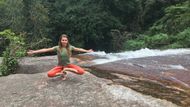
Nada Yoga
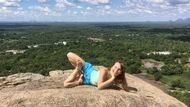
True Essence of Yoga


